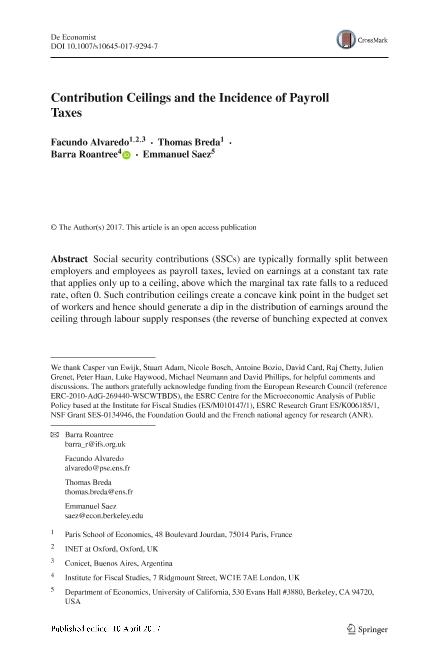Mostrar el registro sencillo del ítem
dc.contributor.author
Gonzalez Alvaredo, Facundo

dc.contributor.author
Breda, Thomas
dc.contributor.author
Roantree, Barra
dc.contributor.author
Saez, Emmanuel
dc.date.available
2018-04-05T16:01:45Z
dc.date.issued
2017-06
dc.identifier.citation
Gonzalez Alvaredo, Facundo; Breda, Thomas; Roantree, Barra; Saez, Emmanuel; Contribution Ceilings and the Incidence of Payroll Taxes; Springer; Economist; 165; 2; 6-2017; 129-140
dc.identifier.issn
0013-063X
dc.identifier.uri
http://hdl.handle.net/11336/40879
dc.description.abstract
Social security contributions (SSCs) are typically formally split between employers and employees as payroll taxes, levied on earnings at a constant tax rate that applies only up to a ceiling, above which the marginal tax rate falls to a reduced rate, often 0. Such contribution ceilings create a concave kink point in the budget set of workers and hence should generate a dip in the distribution of earnings around the ceiling through labour supply responses (the reverse of bunching expected at convex kink points) but such a dip is not observed empirically. This paper sets out a new approach to infer the incidence of SSCs that exploits the absence of this dip and the fact that (mechanically) the distributions of labour cost (earnings inclusive of all payroll taxes), gross earnings (net of employer payroll taxes) and net earnings (net of both employer and employee payroll taxes) cannot all be smooth around a kink. The other papers in this special issue apply the method to data for Germany, France, the Netherlands and the UK and all find that distribution of gross earnings is smooth around kinks (implying that the distributions of labour costs and net-of-tax earnings are not) even though the concept of gross earnings is irrelevant in the standard static model of labour supply and demand that dominates the public economics literature. This suggests that other features of the labour market, such as wage bargaining based on the gross earnings concept, are relevant for determining the incidence of SSCs.
dc.format
application/pdf
dc.language.iso
eng
dc.publisher
Springer

dc.rights
info:eu-repo/semantics/openAccess
dc.rights.uri
https://creativecommons.org/licenses/by-nc-sa/2.5/ar/
dc.subject
Public Economics
dc.subject
Social Security Contributions
dc.subject
Tax Incidence
dc.subject.classification
Economía, Econometría

dc.subject.classification
Economía y Negocios

dc.subject.classification
CIENCIAS SOCIALES

dc.title
Contribution Ceilings and the Incidence of Payroll Taxes
dc.type
info:eu-repo/semantics/article
dc.type
info:ar-repo/semantics/artículo
dc.type
info:eu-repo/semantics/publishedVersion
dc.date.updated
2018-04-05T14:38:33Z
dc.identifier.eissn
1572-9982
dc.journal.volume
165
dc.journal.number
2
dc.journal.pagination
129-140
dc.journal.pais
Estados Unidos

dc.description.fil
Fil: Gonzalez Alvaredo, Facundo. Paris School of Economics; Francia. Consejo Nacional de Investigaciones Científicas y Técnicas; Argentina
dc.description.fil
Fil: Breda, Thomas. Paris School of Economics; Francia
dc.description.fil
Fil: Roantree, Barra. Institute for Fiscal Studies; Reino Unido
dc.description.fil
Fil: Saez, Emmanuel. University of California at Berkeley; Estados Unidos
dc.journal.title
Economist

dc.relation.alternativeid
info:eu-repo/semantics/altIdentifier/doi/http://dx.doi.org/10.1007/s10645-017-9294-7
dc.relation.alternativeid
info:eu-repo/semantics/altIdentifier/url/https://link.springer.com/article/10.1007%2Fs10645-017-9294-7
Archivos asociados
